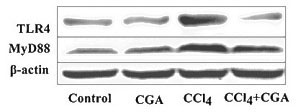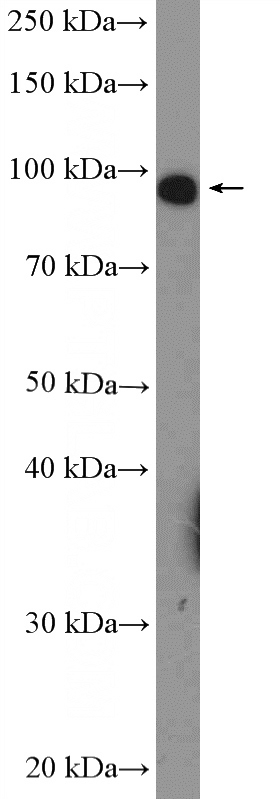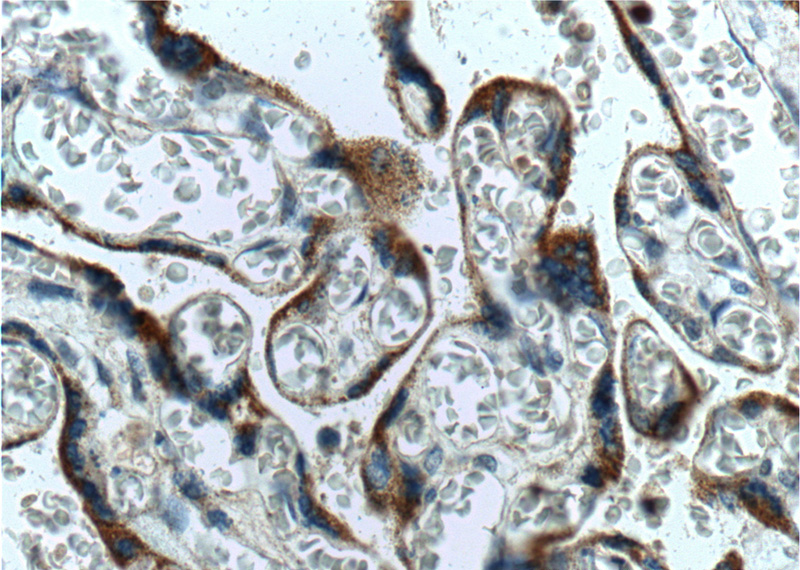-
Product Name
TLR4 antibody
- Documents
-
Description
TLR4 Rabbit Polyclonal antibody. Positive WB detected in mouse liver tissue, rat liver tissue. Positive IHC detected in human placenta tissue, human liver cancer tissue. Observed molecular weight by Western-blot: 90-100 kDa
-
Tested applications
ELISA, WB, IHC
-
Species reactivity
Human, Mouse, Rat, Bovine; other species not tested.
-
Alternative names
ARMD10 antibody; CD284 antibody; hToll antibody; TLR4 antibody; TOLL antibody; toll like receptor 4 antibody
-
Isotype
Rabbit IgG
-
Preparation
This antibody was obtained by immunization of TLR4 recombinant protein (Accession Number: NM_138554). Purification method: Antigen affinity purified.
-
Clonality
Polyclonal
-
Formulation
PBS with 0.02% sodium azide and 50% glycerol pH 7.3.
-
Storage instructions
Store at -20℃. DO NOT ALIQUOT
-
Applications
Recommended Dilution:
WB: 1:200-1:2000
IHC: 1:20-1:200
-
Validations

Protein expression levels of TLR4 in the liver of CGA (chlorogenic acid)- and CCl4-treated rats were measured by Western blot using TLR4 antibody Catalog No:116074. Shi H, et al. Toxicology. 303:107-14 (2013).

mouse liver tissue were subjected to SDS PAGE followed by western blot with Catalog No:116074(TLR4 Antibody) at dilution of 1:600

Immunohistochemistry of paraffin-embedded human placenta tissue slide using Catalog No:116074(TLR4 Antibody) at dilution of 1:200 (under 10x lens).

Immunohistochemistry of paraffin-embedded human placenta tissue slide using Catalog No:116074(TLR4 Antibody) at dilution of 1:200 (under 40x lens).
-
Background
TLR4, also named as CD284, belongs to the Toll-like receptor family. TLR4 cooperates with LY96 and CD14 to mediates the innate immune response to bacterial lipopolysaccharide (LPS). TLR4 acts via MYD88, TIRAP and TRAF6, leading to NF-kappa-B activation, cytokine secretion and the inflammatory response. Three alternatively spliced transcript variants that encode different protein isoforms have been described. The calculated molecular weightsf three TLR4 isoforms are 96, 91, and 73 kDa.
-
References
- Shi H, Dong L, Jiang J. Chlorogenic acid reduces liver inflammation and fibrosis through inhibition of toll-like receptor 4 signaling pathway. Toxicology. 303:107-14. 2013.
- Shi H, Dong L, Dang X. Effect of chlorogenic acid on LPS-induced proinflammatory signaling in hepatic stellate cells. Inflammation research : official journal of the European Histamine Research Society ...
- Li Y, Zhang H, Zhang H, Kosturakis AK, Jawad AB, Dougherty PM. Toll-like receptor 4 signaling contributes to Paclitaxel-induced peripheral neuropathy. The journal of pain : official journal of the American Pain Society. 15(7):712-25. 2014.
- Anisuzzaman , Hatta T, Miyoshi T. Longistatin in tick saliva blocks advanced glycation end-product receptor activation. The Journal of clinical investigation. 124(10):4429-44. 2014.
- Dong D, Yin L, Qi Y, Xu L, Peng J. Protective Effect of the Total Saponins from Rosa laevigata Michx Fruit against Carbon Tetrachloride-Induced Liver Fibrosis in Rats. Nutrients. 7(6):4829-50. 2015.
- Ren WH, Zhang LM, Liu HQ. Protein overexpression of CIRP and TLR4 in oral squamous cell carcinoma: an immunohistochemical and clinical correlation analysis. Medical oncology (Northwood, London, England). 31(8):120. 2014.
- Slusarczyk J, Trojan E, Glombik K. Anti-inflammatory properties of tianeptine on lipopolysaccharide-induced changes in microglial cells involve toll-like receptor-related pathways. Journal of neurochemistry. 136(5):958-70. 2016.
Related Products / Services
Please note: All products are "FOR RESEARCH USE ONLY AND ARE NOT INTENDED FOR DIAGNOSTIC OR THERAPEUTIC USE"
